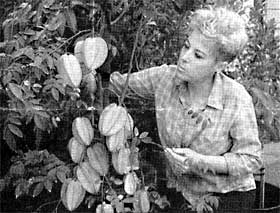By MICHELLE HUNEVEN
From the Los Angeles Times June 23, 1994

David Silber: Ex-engineer with a passion for growing tropical fruits
David Silber still likes to talk about his first tropical fruit. In fact, he and his wife Tina named their Granada Hills nursery after it. And he has a photo album d6cumenting his success with the babaco (pronounced ba-BAH-co) papaya.
In the album are many pictures of Silber, Zsa Zsa Gabor and babacos at a gala tropical-fruit event. In same of the pictures, Zsa Zsa holds the oblong green fruit, the size and shape of a skinny, fluted football. Silber says of Zsa Zsa: “She looks good there – she’s 70 years old, except, as you can see, she’s fat.”
About the babaco, however, Silber has nothing but good things to say! “Such an interesting fruit,” he exclaims. “It’s aromatic and tastes like a cross between a banana and a pineapple, only not as sweet, but that’s OK. You can’t add flavor or aroma to a fruit, but you can add sugar. And there’s no waste with the babaco. It has no seeds and you can eat the skin. The plant is compact, but it’s a big producer.”
One item Silber likes to promote is the Miracle Fruit, a berry that, when chewed, makes acidic things, such as yogurt or lemons, taste sweet.
In another photo album, there are pictures of award-winning babaco pies and cakes and savory dishes that Tina created. When sliced, the deep – yellow babaco makes a pretty star shape with a hollow center that Tina often fills with deep-purple passion fruit. These days, the babaco is only one of 65 rare and exotic plant species the Silbers propagate and grow at the Papaya Tree Nursery. This nursery/demonstration orchard is located in the yard around the Silbers’ white and gold-ocher ranch-style home. There is no sign outside, but those with an eye for unusual flora won’t find the place difficult to spot. In a neighborhood of lawns and shade trees and rose bushes, the Silbers’ is the only house surrounded by caper bushes, persian mulberries, banana trees, tropical guavas and mango trees, with white bags covering the fruit.
David Silber, now in his 50s, gave up engineering at the peak of his career to raise rare tropical and sub-tropical plants. “I’m a kind of guy who likes to do his own thing,” he says. Deeply tanned, with curly silver hair and lively blue eyes, Silber greets his customers in gym sports and a sweatshirt cut off way above the waist. He wears a toothpick behind his ear. He’s cheerful, chatty, philosophical, uninhibited-in the middle of a conversation, he’s likely to squat down suddenly and rock on his toes to stretch his troublesome back.
“I like plants,” he says. “We were vegetable growers before, but all this started 14 years ago, when a neighbor gave us some cherimoya and guava plants-offbeat things. I joined the California Rare Fruit Growers, a club that provides information to growers. I’m a contributing editor with them now – I used to be a reader.”
In the kitchen, Silber slices off a wedge of pepino dulce, a paleorange heart-shaped fruit with fuzzy purple stripes that has suffered, says Silber, from absolutely no promotion. Juicy, vaguely sweet, the pepino dulce tastes like a melon and is related to the tomato. “It’s good marinated in orange juice or served with prosciutto,” he says. A scrub jay flies into the adjacent lanai, perches on a basket handle, and stares expectantly at Silber. Silber calmly shakes chopped nuts from a can and scatters them on the TV tray near the basket.

Tina Silber
As the jay eats his nuts, I’m given a chunk of ice cream banana, also called a blue Java, a thick, waxy-looking fruit that-although not as sweet as tiny supermarket manzano bananas-does indeed have good flavor and a dense, creamy texture. Silber next cuts into a purple passion fruit, which is commercially grown in Hawaii. The dark center looks like inky tapioca and has a very strong, very rich, slightly fetid flavor. Silber explains, “It’s used only as a condiment-it’s too strong to eat by itself.”
To counter the passion fruit, there’s the creamy, smooth, sweet white sapote from Mexico. “Mix it with ice, milk, a little sugar and you have an excellent milk shake,” says Silber.
Before we leave the kitchen to tour the grounds, there’s a slice of Dorset golden apple, a handsome, well-shaped yellow fruit with attractive, blushing shoulders, a beguiling crispness and friendly sweet taste.
In general, Silber searches out high-quality, large-fruited species that grow well in Southern California. “Once I find a species, I develop mass propagation techniques, although mass, in my case, is probably seven or eight plants.” Silber laughs. “I’m inquisitive, more so than average. I want to know things. I’m in a restaurant shaking pepper on my food and I think, ‘Where does pepper come from? A tree? A bush?’ A vine, I find out. I do some research. I got some vines, but I killed them.
Tags: David Silber, Granada Hills, Papaya Tree Nursery, Tina Silber

